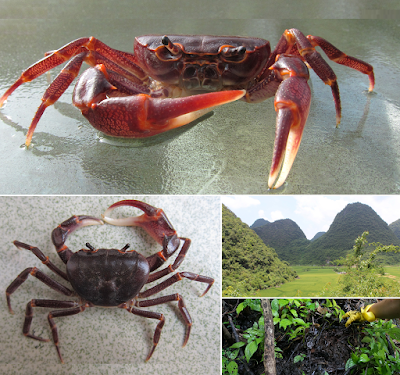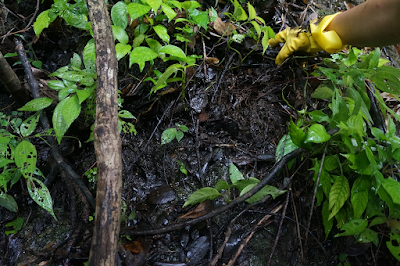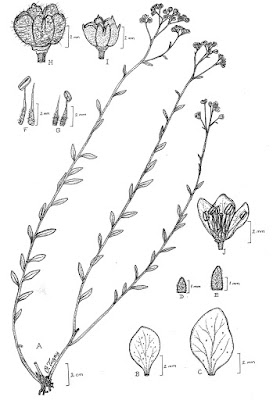 |
| Chinapotamon maolanense
Zou, Bai & Zhou, 2018
|
Abstract
Chinapotamon maolanense sp. n. from Maolan National Nature Reserve, Guizhou, southwest China, is described. C. maolanense sp. n. has diagnostic features of Chinapotamon, such as a slender and sinuous male first gonopod, prominently convex carapace, and one-third ratio of frons to carapace width. This new species can be distinguished from congeners by the combination of the following characters: relatively slender subterminal segment of the first gonopods, nearly oval-shaped carapace, anterolateral margin cristate of carapace and an oval-shaped gap between the fingers of the male major chela. In addition, we used a 16S rRNA gene fragment to explore the relationship between C. maolanense sp. n. and C. glabrum, C. depressum and other freshwater crabs distributed in Guizhou; the results support the new species being assigned to Chinapotamon and clearly different from other species used in the analysis.
 |
| Figure 7: Living color. (A and B) Chinapotamon maolanense n. sp. Paratype male (32.9 × 25.1 mm) (NCU MCP 196102). Photograph courtesy of Xian-min Zhou, October 2010. |
Family Potamidae Ortmann, 1896
Chinapotamon Dai & Naiyanetr, 1994
Chinapotamon maolanense sp. n. (Figs. 2–7)
Materials examined. Holotype: ♂ (35.8 × 25.9 mm) (NCU MCP 196101), ..., Baixian Hill, Banzhai Village, Lino County, Guizhou Province, ..., 532 m asl. Xian-min Zhou, October 2010.
Paratypes: 1♀ (allotype) (36.7 × 26.6) (NCU MCP 196107), same data as holotype; 1♂ (32.9 × 25.1 mm) (NCU MCP 196102). Others: 5♂ (40.4 × 30.9, 30.2 × 22.8, 28.9 × 21.4, 27.8 × 20.7, 27.7 × 19.5) (NCU MCP 196103, 196105, 196106, 196109, 196110), same data as holotype; and 2♀ (38.5 × 29.7, 31.6 × 23.5) (NCU MCP 196104, 196108), same data as holotype.
Description. Carapace nearly oval, widest at anterior one-third, 1.3–1.4 times as broad as long (mean = 1.34, specimens in the Materials examined sections were measured); dorsal surface (Figs. 2A and 2B) smooth, with inconspicuous small granular depression, prominently convex horizontally at anterior one-third and bent forward and backward. Branchial regions slightly convex laterally, with inconspicuous granular depressions. Epigastric cristae low, separated by a narrow gap; central part of the epigastric region slightly depressed. Postorbital cristae very low, not fused with epigastric cristae. Anterolateral margin distinctly cristate, lined with granules. Frons approximately one-third as wide as the carapace. Orbits (Fig. 2C) suboval. Epistome longitudinally narrow, posterior margin with blunt median lobe (Fig. 2B). Ocular peduncle (Fig. 2C) relative slender, medially constricted, distal end (cornea) and base with approximately same diameter.
Etymology. The species is named after the type locality: the Maolan National Nature Reserve.
 |
| Figure 1: Typical karst terrain of Maolan National Nature Reserve.
Photo: Xian-min Zhou, August, 2017.
|
 |
| Figure 8: Habitat of Chinapotamon maolanense n. sp. at the type locality.
Photograph: Xian-min Zhou, October, 2010.
|
Ecological note. Karst terrain usually lacks soil and water, but in karst forests such as the Maolan National Nature Reserve, water could be conserved by dead branches and deciduous layers, and groundwater is another source. C. maolanense sp. n. crabs are locally known as “mountain crabs” because the species is generally distributed in low-altitude mountain forests. This species inhabits small mountain streams with low water flow and even moist soil where the surface has no flow; in contrast, most other Chinapotamon species live under stones in streams, while C. dashiwei and C. clarkei live in streams in caves. This species inhabits environments with dead leaves, dead branches, and humus (Fig. 8).
Remarks. Chinapotamon is characterized by the sinuous and slender G1, prominently convex dorsal surface of the carapace, and frons approximately one-third as wide as the carapace (Dai, 1999; Ng, 2017). C. maolanense sp. n. has all these features. Compared with the other Chinapotamon species, the shape of the G1 of C. maolanense sp. n. is similar to that of C. anlongense, C. depressum, C. dashiwei, and C. clarkei, but the terminal segment of the G1 of the new species is fairly straight, whereas those of the other four species are clearly curved. The subterminal segment of the G1 of C. maolanense sp. n. is almost as slender as the terminal segment, but the subterminal segment of the other four species are clearly stouter than the terminal segment. Additionally, the nearly ovate and prominent convex carapace, the large, oval-shaped gap between the fingers of the male major chela, and the uncountable granular teeth along the anterolateral margin of C. maolanense sp. n. are all distinguishable features (Table 2).
General Discussion:
China has the largest area of karst in the world, most of which is located in the subtropical climate zone in southern China (Liu et al., 2014; Zhou, 1987). Based on theoretical inference or speculation due to existing forest fragments, these karst landforms are believed to have been covered with dense forest vegetation before human influence, but these forests are gradually disappearing and are nearly destroyed (Han, Tang & Wu, 2010). Thus, the discovery of the Maolan karst forest and the primitiveness and richness of the forest vegetation in this area have attracted attention from researchers (Han, Tang & Wu, 2010), but biodiversity surveys in this region have mainly focused on plants (Zhou, 1987). Among the collections of freshwater crab specimens in this area, we found a new species described herein as C. maolanense sp. n.
Most known Chinapotamon species are distributed in Guangxi and Guangdong Provinces, China, except for C. anlongense and C. xingrenense from southwest Guizhou Province, where the average altitude is 1,000–2,000 m. Dai (1999) also collected observations at altitudes above 1,000 m. However, the average altitude of the type locality of C. maolanense in southern Guizhou Province is approximately 500 m, and the main terrain of this area is a low karst peak cluster instead of high mountains. In contrast to the other karst-dwelling crabs, the specimens of C. maolanense were not collected from caves but rather from the humus layer in the forest with small water flow or even just a wet environment; this is a rare habitat for freshwater crabs. In this case, we speculate that this species may have more athletic ability.
Jie-Xin Zou, Jun Bai and Xian-Min Zhou. 2018. A New Species of Karst-dwelling Freshwater Crab of the Genus Chinapotamon Dai & Naiyanetr, 1994 (Crustacea: Decapoda: Brachyura: Potamidae), from Guizhou, southwest China. PeerJ. 6:e5947. DOI: 10.7717/peerj.5947









































